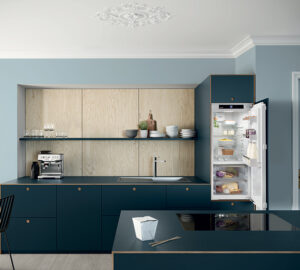If you’re remodeling a kitchen space or starting from scratch to build your dream kitchen from the ground up, one of the most important things to decide is the overall style and aesthetic of your kitchen cabinets.
There are plenty of trending designs to choose from: slab, shaker, glass front, louvered, country-style, beaded, and much more. Each of these styles has their own effect on the interior space’s personality as well as their own advantages and disadvantages. Here, we’ll dive deeper into two of the most popular styles for kitchen units: slab kitchens and shaker kitchens.
When choosing your kitchen cabinets, you’ll need to think about your budget, colour schemes, the amount of space available, as well as storage and maintenance needs. This blog will look at the differences between slab and shaker kitchen cabinets and the pros and cons of each, taking into consideration style, cost and installation. In general, shaker kitchens tend to be seen as more of a traditional option, whilst slab kitchens are seen as more contemporary. However, both are immensely popular options dominating the kitchen industry.
What is a slab style kitchen?

Slab kitchen doors feature a single panel (typically plywood, hardwood or MDF) with a smooth, flat surface and 90° corners, which gives a seamless, continuous appearance to the doors. With no recesses, bevelling or adornments, the uninterrupted look brings a modern and minimalistic feel to the kitchen space. Homeowners and renovators love the uncomplicated style of slab kitchens as they are easy to install, clean and maintain.
Slab-style kitchen cabinets, sometimes known as flat panel kitchen cabinets, can be hardware-free with handleless mechanisms such as push-to-open doors and drawers, or they can be used with hardware that further enhances their clean style, like long, thin handles that contribute to the sleekness of the surface. In general, they are easy to install, and can be fitted with either standard or soft-close hinges.
What are the pros and cons of slab kitchen units?
The lack of embellishments on slab doors makes them especially easy to clean and wipe down, meaning many homeowners find them much easier to maintain than shaker-style cabinets as they collect less dust and dirt. The smooth, uniform appearance of these kitchen units means you can customise them with any colour or finish and they will blend in with the rest of the interior. Their flat surface makes them a lot easier to construct and manufacture than other units with recesses or bevelling, meaning you might find slab doors cost a little less than shaker doors.
The flat surface may create a modern, sophisticated look, but it might also mean that scratches and cracks show up a little more. Also, since slab panels are built from single pieces of material, they might be more prone to warping over time.
What is a shaker style kitchen?

Shaker-style kitchen units feature a wide, raised frame and a flat, recessed centre panel. With two rails at the top and bottom of the panel and two stiles on either side, this distinctive, contoured design brings a more classic and vintage personality to the kitchen space. Rooted in 18th century craftsmanship and named after the Shaker religious movement, shaker kitchen cabinets are widely renowned for their versatility and timelessness.
Shaker doors and panels are typically made from hardwood or MDF, and sometimes feature visible joints such as mortice and tenon or dowel joints, which adds to their vintage, handmade look. As well as the signature recessed panelling, shaker kitchen cabinets have simple, clean lines with minimal detailing or profiling. The traditional character of these cabinets can be further enhanced with accessories such as unique handles and knobs, and assorted colours and finishes depending on your preference.
What are the pros and cons of shaker kitchen cabinets?
A traditional shaker kitchen is not only attractive, but timeless too. The units are very customisable, so you can add different hardware, colours and finishes to create either a traditional or a more contemporary look. With an elevated level of craftsmanship, shaker-style interior design is an effortless way to elevate any room and it’s not just seen in kitchens, either: the design can be seen in wall panelling, furniture and more. With shaker kitchens continuing to be fashionable throughout the decades, you can be sure your kitchen won’t become outdated or unattractive over the years.
Due to the additional resources and work needed to create the recessed panels in shaker cabinets, they might be a little more expensive than slab cabinets, and they may be slightly more difficult to install. Also, shaker kitchen cabinets might require a little more TLC when it comes to maintenance – the recessed panels and framing might give the cabinets dimension and character, but it also makes them a little harder to clean and get into all the nooks and crannies.
So, which kitchen style is best for your project?
After fully understanding your budget, measurements, and overall desired look, you should be ready to decide which kitchen units are best for your home. If you’re going for a more traditional or vintage interior, shaker kitchen cabinets can offer that vintage feel with 18th century craftsmanship, although they might be a little more expensive and require more effort to clean. If you’re after something sleeker and more contemporary, then slab kitchen cabinets might be for you – just remember it might be more obvious to notice small marks.
Whichever style you land on, both slab-style and shaker-style kitchens are extremely popular and with plenty of stylish options dominating the market, either one is sure to create a stunning, unique kitchen space for your home.









